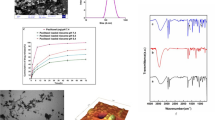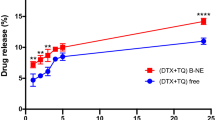Abstract
Doxorubicin (DOX) is an anticancer drug used to treat several cancer diseases. However, it has several dose limitation aspects because of its poor bioavailability, hydrophobicity, and cytotoxicity. In this study, five nanoemulsion (NE) formulations, containing soya phosphatidylcholine/polyoxyethylenglycerol trihydroxy-stearate 40 (EU)/sodium oleate as surfactant, cholesterol (CHO) as oil phase, and Tris–HCl buffer (pH 7.22), were produced. The NE droplets morphologies of the entire blank and DOX-loaded formulations, revealed by the transmission electron microscope, were spherical. The droplet sizes of blank NEs, obtained between 2.9 and 6.4 nm, decreased significantly with the increase in the ratio of surfactant-to-oil, whereas the droplets sizes of DOX-loaded NE formulations were significantly higher and found in the range of 7.7–15.9 nm. The evaluation for both blank and DOX-loaded NE formulations proved that the NE carrier had improved the DOX efficacy and reduced its cytotoxicity. It showed that the cell growth inhibition of the breast cancer cells (MCF-7) have exceeded the commercial DOX by a factor of 1.7 with increased apoptosis activity and minimal cytotoxicity against the normal human foreskin cells (HFS). In contrast, commercial DOX was found to exhibit a significant non-selective toxicity against both MCF-7 and HFS cells. In conclusion, we have developed DOX-loaded NE formulations which selectively and significantly inhibited cell proliferation of MCF-7 cells and increased apoptosis.







Similar content being viewed by others
References
Bawarski W, Chidlowsky E, Bharali D, Mousa S (2008) Emerging nanopharmaceuticals. Nanomedicine 4:273–282
Daocheng W, Mingxi W (2010) Preparation of the core-shell structure adriamycin lipiodol microemulsions and their synergistic anti-tumor effects with diethyldithiocarbamate in vivo. Biomed Pharmacother 64:615–623
Desai A, Vyas T, Amiji M (2008) Cytotoxicity and apoptosis enhancement in brain tumor cells upon coadministration of paclitaxel and ceramide in nanoemulsion formulations. J Pharm Sci 97:2745–2756
Duncan R, Vicent M, Greco F, Nicholson R (2005) Polymer-drug conjugates: towards a novel approach for the treatment of endrocine-related cancer. Endocr Relat Cancer 12:S189–S199
Formarize T, Sarmonto V, Silva-junior A, Scarpa M, Santilli C, Olivera A (2006) Doxorubicin bicompatible O/W microemulsion stabilized by mixed surfactant containing soya phosphatidylcholine. Colloids Surf B Biointerfaces 51:54–61
Fornari FA, Jarvis WD, Grant S, Orr MS, Randolph JK, White FK, Mumaw VR, Lovings ET, Freeman RH, Gewirtz DA (1994) Induction of differentiation and growth arrest associated with nascent (non-oligosomal) DNA fragmentation and reduced c-myc expression in MCF-7 human breast tumor cells after continuous exposure to a sublethal concentration of doxorubicin. Cell Growth Differ 5:723–733
Gavrieli Y, Sherman Y, Ben-Sasson SA (1992) Identification of programmed cell in situ via specific labeling of nuclear DNA fragmentation. J Cell Biol 119:493–501
Hurwitz E, Levy R, Maron R, Wilchek M, Arnon R, Sela M (1975) The covalent binding of daunomycin and adriamycin to antibodies, with retention of both drug and antibody activities. Cancer Res 35:1175–1181
Joseph B, Adam S, Lee J (2011) The slow cell death response when screening chemotherapeutic agents. Cancer Chemother Pharmacol 68:795–803
Kakumanu S, Tagne J, Wilson T, Nicolosi R (2011) A nanoemulsion formulation of dacarbazine reduces tumor size in a xenograft mouse epidermoid carcinoma model compared to dacarbazine suspension. Nanomedicine 7:277–283
Kotmakchiev M, Cetintas V, Kantarci G (2011) Determining in vitro anticancer activity of mitomycin C loaded microemulsion. Curr Opin Biotechnol 22:S127–S128
Kratz F, Beyer U, Collery P, Lechenault F, Cazabat A, Schumacher P, Falken U, Unger C (1998) Preparation, characterization and in vitro efficacy of albumin conjugates of doxorubicin. Biol Pharm Bull 21:56–61
Laginha K, Verwoert S, Charrois G, Allen T (2005) Determination of doxorubicin levels in whole tumor and tumor nuclei in murine breast cancer tumors. Clin Cancer Res 11:6944–6949
Mason T, Wilking J, Meleson K, Chang C, Graves S (2006) Nanoemulsions: formation, structure, and physical properties. J Phys Condens Matter 18:R635–R666
Ohkawa K, Hatano T, Yamada K, Joh K, Takada K, Tsukada Y, Matsuda M (1993) Bovine serum albumin-doxorubicin conjugate overcomes multidrug resistance in a rat hepatoma. Cancer Res 53:4238–4242
Rapoport N, Nam K, Gupta R, Gao Z, Mohan P, Payne A, Todd N, Liu X, Kim T, Shea J, Scaife C, Parker DL, Jeong E, Kennedy AM (2011) Ultrasound-mediated tumor imaging and nanotherapy using drug loaded, block copolymer stabilized perfluorocarbon nanoemulsions. J Control Release 153:4–15
Seymour L, Ulbrich K, Strohalm J, Kopecek J, Duncan R (1990) The pharmacokinetics of polymer-bound adriamycin. Biochem Pharmacol 39:1125–1131
Siddiqui I, Adhami V, Bharali D, Hafeez B, Asim M, Khwaja S, Ahmad N, Cui H, Mousa S, Mukhtar H (2009) Introducing nanochemoprevention as a novel approach for cancer control: proof of principle with green tea polyphenol epigallocatechin-3-gallate. Cancer Res 69:1712–1716
Singla AK, Garg A, Aggarwal D (2002) Paclitaxel and its formulations. Int J Pharm 235:179–192
Skehan P, Storeng P, Scudiero D, Monks A, McMahon J, Vistica D, Warren JT, Bokesch H, Kenney S, Boyd MR (1990) New colorimetric cytotoxicity assay for anticancer-drug screening. J Natl Cancer Inst 82:1107–1112
Su M, Zhao M, Luo Y, Lin X, Xu L, He H, Xu H, Tang X (2011) Evaluation of the efficacy, toxicity and safety of vinorelbine incorporated in lipid emulsion. Int J Pharm 411:188–196
Talekar M, Ganta S, Singh A, Amiji M, Kendall J, Denny WA, Garg S (2010) Phosphatidylinositol 3-kinase inhibitor (PIK75) containing surface functionalized nanoemulsion for enhanced drug delivery, cytotoxicity and pro-apoptotic activity in ovarian cancer cells. Pharm Res 29:2874–2886
Venkateshwarlu I, Prabhakar K, Ali M, Kishan V (2010) Development and in vitro cytotoxic evaluation of parenteral docetaxel lipid nanoemulsions for application in cancer treatment. PDA J Pharm Sci Technol 64:233–241
Wang J, Costantino J, Tan-Chiu E, Wickerham D, Paik S, Wolmark N (2004) Lower-category benign breast disease and the risk of invasive breast cancer. J Natl Cancer Inst 96:616–620
Wang M, Shin D, Simons J, Nie S (2007) Nanotechnology for targeted cancer therapy. Expert Rev Anticancer Ther 7:833–837
Acknowledgments
The authors wish to express a sincere thanks and appreciation to King Abdulaziz City for Science and Technology for its financial support to the research project designated by number (P-S-10-0016), King Abdulaziz University Hospital for providing cell cultures and King Fahd Medical Research Center, Jeddah, KSA, for technical support.
Author information
Authors and Affiliations
Corresponding author
Rights and permissions
About this article
Cite this article
Alkhatib, M.H., AlBishi, H.M. In vitro evaluation of antitumor activity of doxorubicin-loaded nanoemulsion in MCF-7 human breast cancer cells. J Nanopart Res 15, 1489 (2013). https://doi.org/10.1007/s11051-013-1489-5
Received:
Accepted:
Published:
DOI: https://doi.org/10.1007/s11051-013-1489-5




